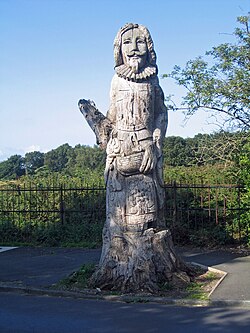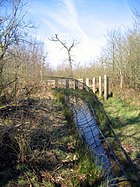Hale, Lancashire: Difference between revisions
Created page with '{{infobox town |name=Hale |county=Lancashire |picture=Hale Childe 1.jpg |picture caption=John Middleton statue in Church End |os grid ref=SJ468824 |latitude=53.33673 |longitude=-…' |
|||
| Line 33: | Line 33: | ||
==References== | ==References== | ||
{{reflist}} | {{reflist}} | ||
[[Category:Extreme points of Lancashire]] | |||
Latest revision as of 17:19, 19 September 2015
| Hale | |
| Lancashire | |
|---|---|
 John Middleton statue in Church End | |
| Location | |
| Grid reference: | SJ468824 |
| Location: | 53°20’12"N, 2°48’0"W |
| Data | |
| Population: | 1,898 (2001) |
| Post town: | Liverpool |
| Postcode: | L24 |
| Dialling code: | 0151 |
| Local Government | |
| Council: | Halton |
| Parliamentary constituency: |
Halton |
Hale is a village in Lancashire. It stands by the northern bank of the tidal River Mersey where the river's course dips to the south. The Mersey forms the county boundary with Cheshire on the south bank and Hale Head, in the river bend, is the southernmost point of Lancashire.
Hale is 2½ miles east of Speke in Liverpool, and 4 miles south-west of Widnes. The nearby village of Halebank is to the north-east.
The Childe of Hale
The most famous son of Hale was John Middleton (1578-1623), known as the Childe of Hale. A veritable giant, he was reputed to be nine foot three inches tall. His cottage and grave are located in the village. Just outside St Mary's Church is a carving of the Childe Of Hale which is said to be life size.
Hale Duck Decoy

The Hale Duck Decoy is a Scheduled Ancient Monument near the village. The decoy covers an area of 5 acres, which is surrounded by a moat crossed by a swing bridge..[1] It has the shape of an irregular pentagon[2] which contains a central pool with five "arms" (ditches with wire covers to form pipes) radiating from it. Within the decoy is a gamekeeper's cottage.
The decoy is accessible, but only to guided tours of up to 20 people.[2]
When the Duck Decoy was built is not known, but there is evidence that it was built in the 17th century. Records show that in 1754 it was repaired and improved by its owner at that time, Mr Ireland-Blackburne.[2] In 1886, now owned by Colonel J Blackburne, MP, it was still being worked.]].[2] By the early 20th century it became disused.
In the 1960s a conservation group began to restore the Decoy. A lease was then taken by the local councils to continue the restoration.[3] It has subsequently received a grant from the Heritage Lottery Fund to develop it into a nature reserve. In 1991 its walls were breached by a high tide and this was followed by a programme of replanting the trees which had been lost.
References
- ↑ Pollard, Richard; Nikolaus Pevsner (2006). The Buildings of England: Lancashire: Liverpool and the South-West. New Haven & London: Yale University Press. p. 191. ISBN 0 300 10910 5.
- ↑ Hale Duck Decoy, Halton Borough Council, http://www2.halton.gov.uk/nature/content/localnaturereserves/haleduckdecoy/?a=5441, retrieved 4 October 2008
- ↑ Hale Duck Decoy, BBC, http://www.bbc.co.uk/liverpool/content/articles/2005/05/11/duck_decoy_feature.shtml, retrieved 4 October 2008